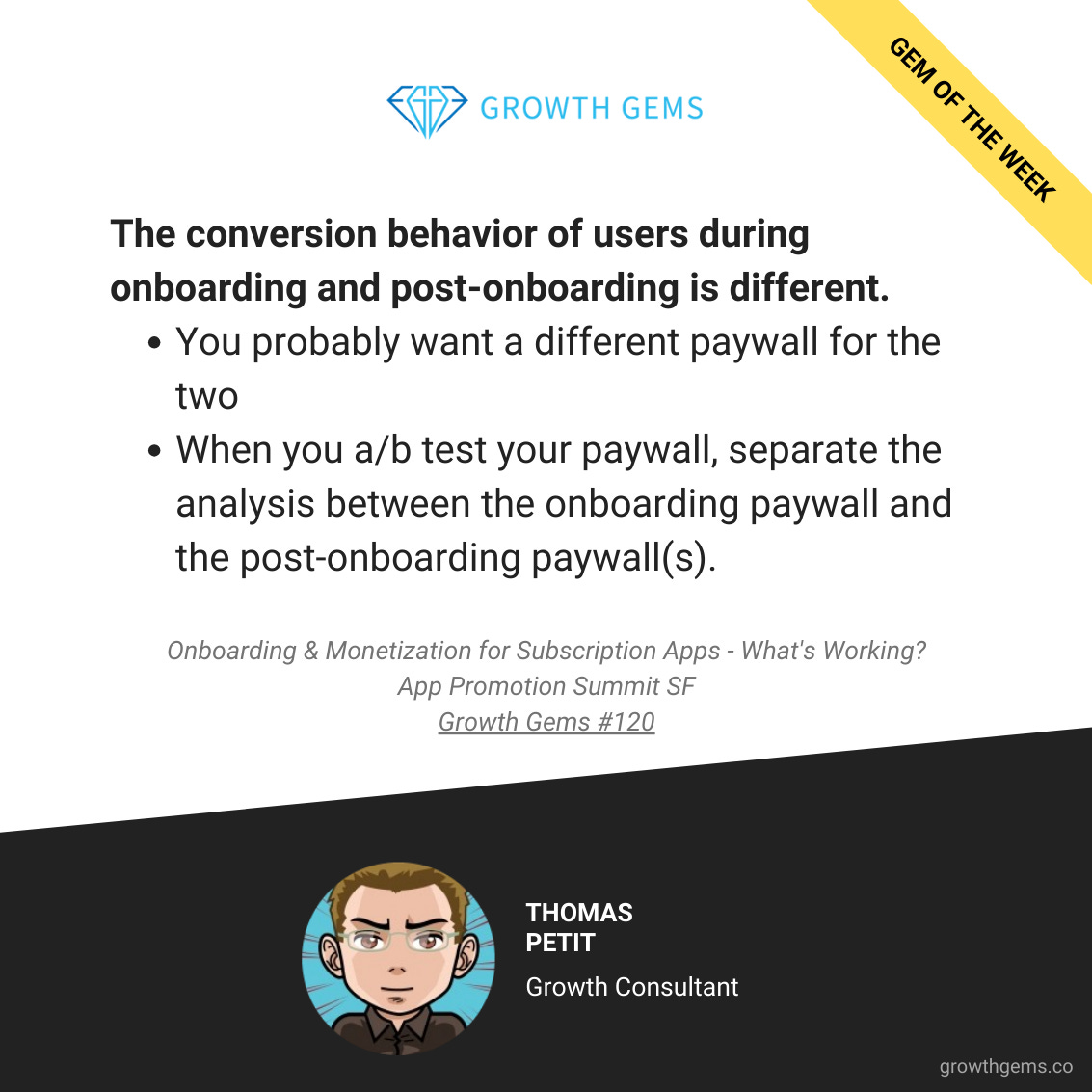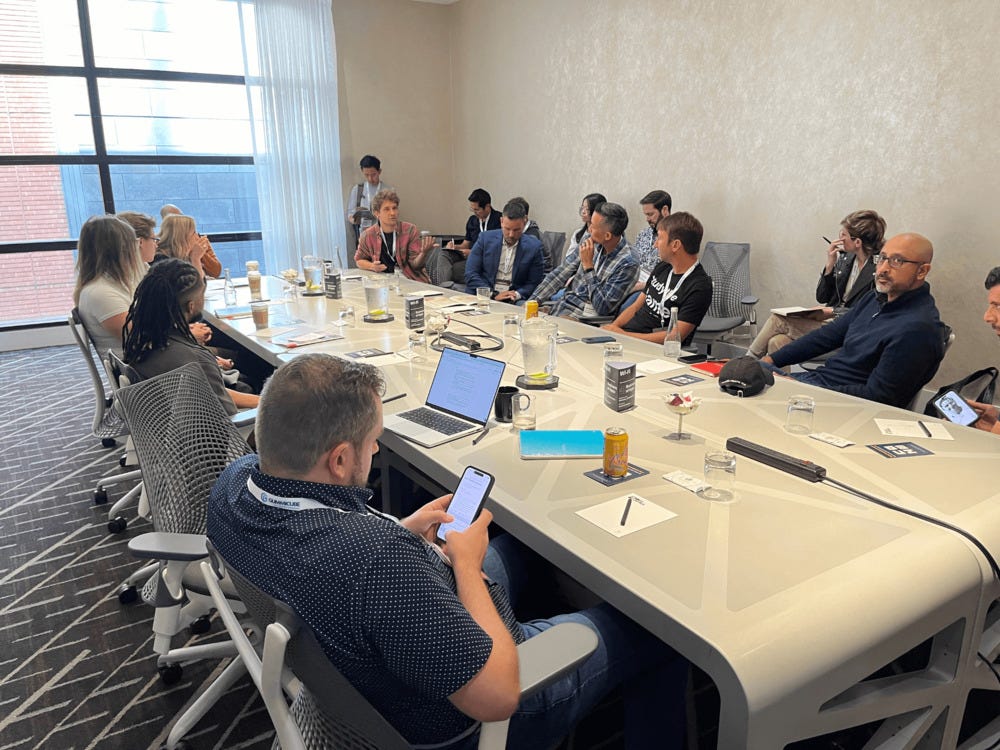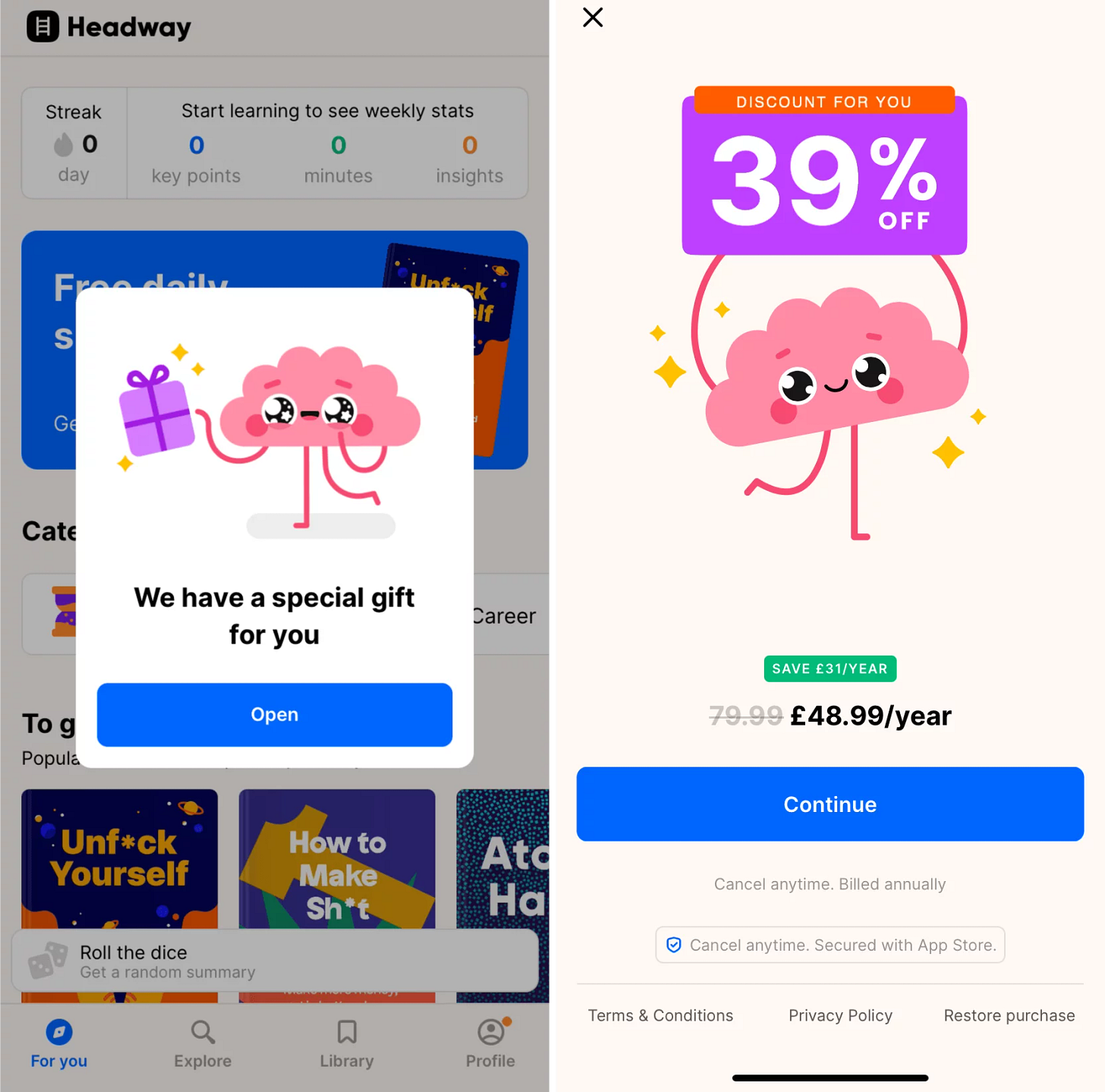I dug up some special gems 💎 during my last shift in the growth mine…I’m bringing you back insights on:
Onboarding and activation approach
Monetization and the Premium <> Freemium dilemma
The UA <> Monetization relationship
Mined in person this time, I have no doubt these hard-dug insights from Thomas Petit will be valuable.
🥇 TOP GEM OF THE WEEK
Onboarding & Monetization for Subscription Apps - What's Working?
Gems from Thomas Petit (Growth Consultant) from Onboarding & Monetization for Subscription Apps - What's Working? at the App Promotion Summit SF.
I shared gems from the kick-ass RevenueCat App Growth Annual event in Growth Gems #119.
But what also made the San Francisco trip epic was the App Promotion Summit event the next day.
I skipped the vendor talks (no offense - I can still watch them online) and camped in the Roundtable room…For some of the best discussions on Growth I’ve had recently.
Today, I’m sharing the insights from Thomas’ roundtable.
Onboarding and activation approach
💎 When you start seeing diminishing returns (lower success rate, smaller wins) on a type of tests (e.g., paywall, parts of the onboarding, etc.), it is a signal that it's time to explore other areas to test.
This is similar to the insights shared by Sviat Hnizdovskyi (CEO at Applica) in Growth Gems #92, in which he explains their Experiment Framework and approach.
💎 The conversion behavior of users during onboarding and post-onboarding is different.
You probably want a different paywall for the two
When you a/b test your paywall, separate the analysis between the onboarding paywall and the post-onboarding paywall(s).
💎 Ways to approach a long onboarding:
Copy a competitor, then iterate
Balance asks and education/nice moments. Start with easy questions and motivating/fun screens.
Bundle your screens in sections/modules that make logical sense (e.g., age, weight)
💎 You don’t need someone to sign up via email before you get them to purchase. It makes things more complicated, but it might be worth it in some cases. For example, you can show a paywall very early on (e.g., pre or mid-onboarding).
To learn more about how to do this, head over to the thread Showing Paywall Before Authentication in the Sub Club community.
💎 If you need to split users during onboarding to provide a different experience (e.g., team use case, professional use case), one way besides asking a direction question is to figure out some specific activity they need to do to progress on that branch (e.g., add colleagues). Just be careful of the added friction that you’re introducing.
💎 Simplify the app post-onboarding to drive users to the most important action you want them to do. You can delay showing features until some progress has been made.
Headspace takes non-trialers and trialers through a first meditation before dropping them on the main tab.
The Impulse example below feels pretty strong because they:
Tease a reward for completing games
Customize the first game they open by default
Imprint, like several others, customizes the top of the main tab they drop you on to have a clear “Start” CTA.
If you know of some that actually delay showing features, hit reply and let me know!
💎 If you see users that retain better because they do a specific activation activity, don’t conclude that it means you should force all users to that path: they may retain better because they search for or found the activity, and driving more people there might not lead to overall retention improvements
The Freemium <> Premium spectrum
💎 Having multiple paywalls during onboarding is a great way to increase the install -> paywall view metric, and often conversions. However, one important consideration is how important the free cohort is for you because multiple paywalls moves your place on the freemium <> premium spectrum.
This is a strategic decision. Here is the “spectrum” that Thomas shared a few times before”.
This is also not a decision set in stone: it might very well be justified to start with a hard paywall when looking for product market fit and initial traction, then move towards freemium. Kenneth Schlenker (CEO at Opal) actually recommended this in his insights from Growth Gems #108.
💎 “Aggressiveness of monetization” comes in many different shades, and those “tricks” often works: toggles, wheel of fortune on or after the paywall, backup offers, fake loading screens, etc. But you need to find the balance so you don’t give an overall scammy feeling.
You’ve probably seen the “free trial toggle” before, but if not, here is one example:
And what is the wheel of fortune, you may ask? Below is an example courtesy of Victoria.
It doesn’t have to be a wheel. Here are other examples (first one courtesy of Murat).
Finally, Headway is famous for its back-up offers:
Separately, those tactics might just bring you great wins…But combine too many of them and you might give a certain feeling to users. An example of that is the Me+ onboarding: this goes past MY personal threshold and would prevent me from converting or at least categorize the app as sneaky/cheap (typos don’t help).
💎 Put your best content for free. Paid users typically don't know what's gated or not, and it shows the best value to everyone.
This is something that Faye Keegan (CEO of Dipsea, acquired by RevenueCat) mentioned in the Sub Club podcast episode Pioneering a New Genre of Audio App: If you limit the possible “happy” paths in the free experience to the ones you think have the highest value, you’re probably going to do the best.
Elena Verna recently wrote Should your new feature be free or paid? and one of the arguments for putting something in the freemium tier was that if the free version of your product doesn't receive updates or new features, it can become stale and less appealing. Another good point she made is that “freemium defines your product’s brand”.
💎 It’s a huge asset to have a strong community outside of the app that talks together, etc. but it can make things challenging when it comes to monetization.
One way to solve for that, and leverage this community, is to ask for donations. Donating becomes a “badge of honor”: users become ambassadors and benefit from social influence.
Think you can’t make money with donations? Ask TikTok!
Patreon also comes to mind, even though they were recently forced to switch to in-app purchases for donations to their members (but that’s to be expected).
It got me curious, though: what if donations was what you use as a back-up offer? Is anybody doing that? I’ve seen it done with “pay what you want” offers (a few price point choices), but never with donations.
The UA <> Monetization relationship
💎 Monetization tests or changes can drastically impact UA. Potential gain in monetization can have a long-term impact, justifying the disruption of acquisition stability in the short term. Example: adding/removing a free trial toggle, switching to purchases, etc.
💎 Communications between the monetization and UA teams should go both ways to pick the right moments to test. You can also compromise based on the test “risk profile”: timing, geos involved, % of users on which an experiment is tested, etc.
Examples: Don’t launch an impactful monetization experiment right when the UA team opens up a new channel (or vice versa).
Before I leave, here is a quote from a RevenueCat webinar leading to their App Growth Annual event:
“Growing organically is like training in altitude” - Phil Carter (Growth Advisor at Elemental Growth)
See you next time.
Stay curious!
⛏️ Sylvain
🔗 Sources:
Onboarding & Monetization for Subscription Apps - What's Working? at App Promotion Summit SF













